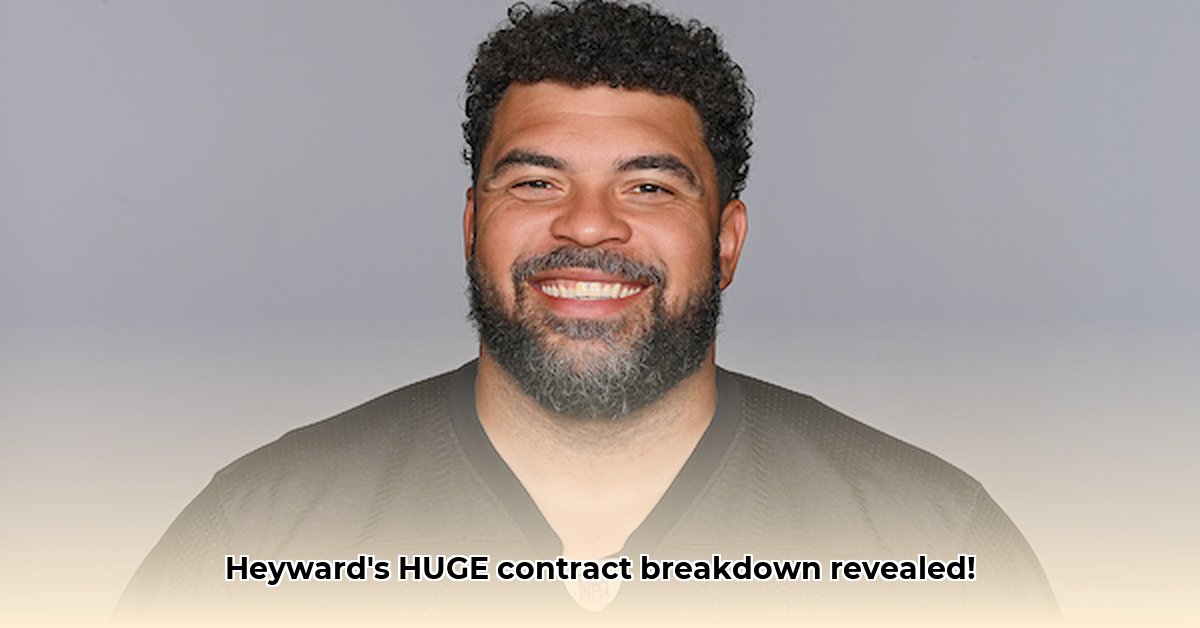
Cameron Heyward's recent contract extension with the Pittsburgh Steelers presents a compelling case study in NFL player valuations. While the two-year, $29 million deal immediately grabs attention, a deeper dive reveals a complex financial strategy with significant implications for both Heyward and the Steelers. This analysis dissects the contract's structure, explores its impact on his net worth, and considers the broader context of NFL salary cap dynamics.
Decoding the Deal: Performance-Based Incentives and Strategic Risk
Heyward's contract isn't a simple salary increase; it's a performance-based gamble. A significant portion hinges on roster bonuses payable in 2025 and 2026, directly linking his earnings to his continued health and on-field success. This structure allows the Steelers to manage their immediate salary cap burden more effectively, freeing resources for other players or financial needs. However, it introduces considerable risk: a major injury could significantly reduce Heyward's earnings while leaving the Steelers with a potentially problematic dead cap situation. How does this risk-reward calculation play out in the long term for both parties?
Market Value Analysis: Comparing Heyward's Deal to Peers
To accurately assess Heyward's contract value, it's crucial to benchmark it against similar deals for veteran defensive tackles. How does his compensation compare to players with similar age, experience, and performance levels? The market value analysis will help determine if the contract represents fair market value, a steal for Heyward, or a shrewd move for the Steelers that may have left some money on the table. This comparative analysis forms the bedrock for projecting his overall net worth beyond the immediate contract terms.
The Age Factor: Balancing Experience and Longevity in Contract Negotiations
At 36, Heyward is nearing the end of his NFL career. While he maintains elite performance, the inevitable decline associated with age and wear presents a considerable risk factor in evaluating long-term financial projections. This analysis meticulously weighs his current performance against the potential for future injury, decline in play, and the contract's ability to fairly account for a potential reduction in productivity over its two-year duration.
Beyond the Gridiron: Investments, Endorsements, and Post-NFL Income Streams
Projecting Heyward's net worth beyond the contract's lifespan requires looking beyond his football earnings. His astute investments, profitable endorsement deals, and potential future ventures, such as coaching or broadcasting, will significantly influence his overall financial picture. These off-field income streams are key factors in constructing a comprehensive estimate of his total net worth. What are the chances of Heyward successfully managing his resources to create exponential wealth beyond his football career?
The Steelers' Long-Term Strategy: Salary Cap Management and Future Roster Development
The Steelers’ approach to Heyward's contract isn't solely about the next two seasons; it’s part of a long-term plan. Managing the salary cap effectively is paramount to the team's sustainability and competitive edge. While Heyward remains a cornerstone, the Steelers must concurrently develop younger talent at the defensive line position to ensure a smooth transition when Heyward retires. They are balancing their current need for a high-performing player with the long-term health of their team’s finances and roster structure.
Stakeholder Analysis: Short-Term Gains and Long-Term Objectives
The following table summarizes the interests and objectives of the key stakeholders:
| Stakeholder | Short-Term Goals | Long-Term Goals |
|---|---|---|
| Cameron Heyward | Maximize income, maintain high performance to earn roster bonuses. | Secure financial future beyond football; explore post-NFL business ventures. |
| Pittsburgh Steelers | Maintain a strong defensive line, manage salary cap effectively, and ensure competitiveness. | Develop younger talent, maintain consistent competitiveness, and build a sustainable franchise. |
| NFL Analysts | Analyze contract implications, track Heyward's performance, and assess market value. | Forecast salary cap impacts and future contract trends. |
Analyzing NFL Contracts: A Step-by-Step Guide
Analyzing NFL player contracts, including Heyward's, requires a structured approach:
- Identify Key Components: Base salaries, signing bonuses, roster bonuses, and performance incentives are meticulously examined to understand the total compensation and the yearly impact on the salary cap.
- Uncover Hidden Numbers: Disentangle the headline contract value from annual salary cap implications, considering how bonuses are prorated over the contract lifetime and the yearly financial burden on the team.
- Contextualize Within the Salary Cap: Analyze the contract's impact on the team's annual spending limit and its effect on the team's ability to sign other players.
- Assess Risk: Evaluate inherent risks for both the player (injury) and the team (underperformance).
- Consider Qualitative Factors: Analyze Heyward's on-field performance, age, and projected remaining playing years to understand the contract's value beyond the simple numbers.
Conclusion: A Complex Financial Gamble
Cameron Heyward's contract is more than just a sum of money; it's a calculated financial strategy with inherent risks and rewards for both the player and the team. A comprehensive evaluation necessitates considering various factors, including market value, age-related performance decline, and the overall impact on the Steelers' salary cap strategy. By dissecting all these elements, we arrive at a nuanced understanding of the potential impact on Cameron Heyward's net worth — a net worth that extends far beyond the two years of a contract.